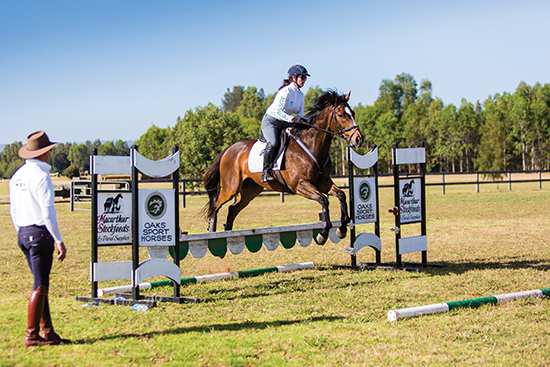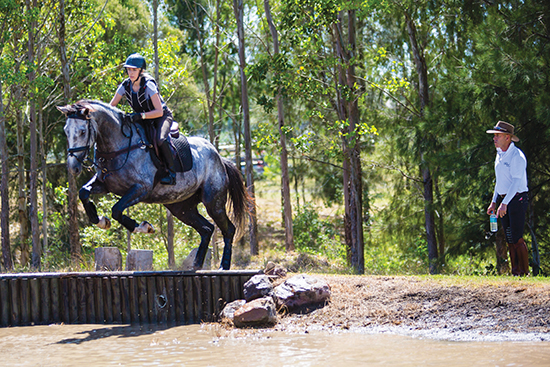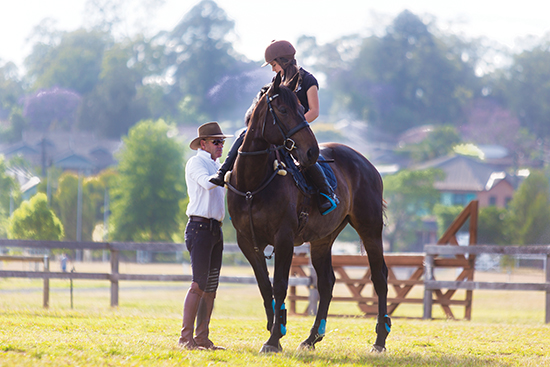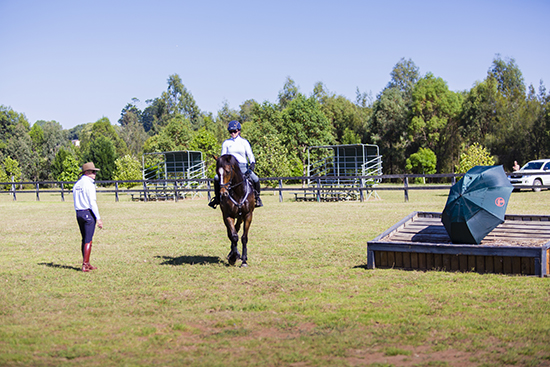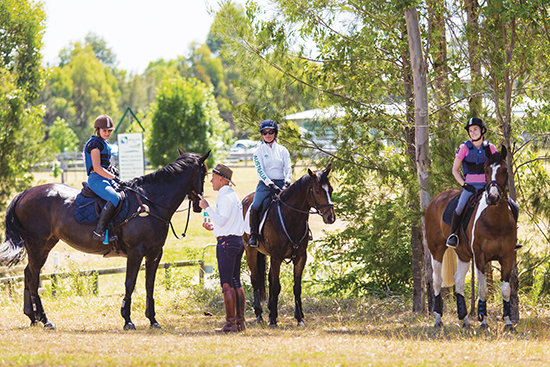 Story and Photos by Rebecca Ashton
Story and Photos by Rebecca Ashton
With Camden’s beautiful cross country course and church bells ringing in the distance, Andrew Hoy may have been forgiven for thinking he was still back in the UK, but with record high temperatures for November, there was no doubt he was well and truly back home in Australia.
It was an early start to beat the heat as Andrew started the clinic by getting the riders to walk and then trot easily over a pole on a circle. This was an exercise he had used the previous day. “Occupy your horse’s mind. For example, yesterday Nat’s (Blundell) horse wanted to buck, so we incorporated the pole on a small circle to make him think about his feet and forget about the bucking.
“It’s our responsibility as a rider to guide our horse. He knows nothing. He doesn’t know I’m about to ask you to jump that jump over there. He hasn’t walked the course. He can’t speak English. We have to help him and we do it by being very clear with our aids.”
“Horses can do everything before you even get on, but what we are teaching them is to do all those things from different pressures. There are only four things you need to teach your horse: Stop, go, turn left, turn right. Don’t make riding more complicated than it is. And what do you need for that? The forward comes from the leg, the hands stop and turn, the seat feels what’s going on under you and the eyes see. That’s it.”
Andrew required the riders to have a good position to give effective aids. Emily Hawker was given some handy tips early in the session, “Emily, you are a little hunched. You need your spine to be in neutral. To get the feeling, I want you to stand in the saddle and ride over the pole. You have to also shorten your reins a bit so you can steer your horse.
Natalie over a jump with a ground pole on the landing side
“Look at Nat as she trots the circle. She’s a good example. She keeps her eyes on the pole the whole time, she rides the rhythm and she also backs up her aids with her voice. Get the rhythm first and from that you can ride forward.
“When you ride towards the pole on a straight line, you only have two options to adjust your approach; forward or back, so you only have half a stride to work with. On a circle, you can lengthen your distance to the outside or shorten it to the inside therefore you have four options. People say you have to be straight to a fence. Yes, you need to be straight when he steps over the pole, but you can approach it on the circle line.”
Rhythm is Andrew’s mantra and it was no different today, “Always have an internal beat, riding the rhythm. If I get anxious about something, I count aloud. It takes you four to five strides to feel the stride, so start counting early.”
Even when the riders were sitting and listening they had to be aware of their influence on the horse, “When you’re just standing there listening, have the rein loose, right to the buckle. Let him shake his head if he wants. It loosens the muscles in his neck.”
Andrew doesn’t miss a beat!
Next it was on to a small jump and Natalie was first cab off the rank.
“For Nat’s young horse we’ve put a pole on the landing side because the highest part of his jump is when he has jumped the fence, not above it so this gets him more centered.”
Emily takes her five-year-old into the water
Emily Hawker was being almost a bit too nice to her horse and Andrew intervened, “Emily, I can tell that you’re a horse lover. I’m a horse lover too, but at the higher levels, you have to direct them. You’re the one with the knowledge and the info. Therefore you have to be very, very clear with your instruction. That doesn’t mean you have to be unfair, but they love good direction or else they feel lost. You have to provide structure for him.”
Hayley Farrar was last to go and it was evident this young rider has a heap of talent, but there were still lessons to be learnt.
Andrew adjusts Hayley’s stirrups
“Hayley, you started well but went through a bad patch because you didn’t ride the rhythm. You knew you were wrong but you didn’t do anything about it. You have to be consequent about it. No-one reaches every fence on the perfect stride, but you have to do something.” Hayley took Andrew’s advice on board and finished with some impressive jumps.
While Nat’s horse was waiting for the others to have a go he started to notice a few things about his surroundings. Andrew explained, “You can see when you give a young horse a break you need to take him back to what you were doing.” The ex-racehorse was terrified of a cross country jump that was off to the side with people sitting on it under an umbrella. The problem had to be dealt with rather than ignored.
Andrew and Natalie deal with scary objects
“What Nat’s doing is really nice. She’s holding him to the jump without pressuring him. See how he just licked his lips a bit there? He’s starting to accept it. I think this is his first time in civilization!”
Then she started riding him in small circles at the walk close to the jump to get his focus back on her. Andrew continued, “This way they’ll be able to deal with all situations. Natalie is very good with her hands and she keeps him moving forward all of the time. She is also using her voice. She’s putting pressure on then releasing, on and release. This is about working with the horse’s mind. I hope you are all watching this. You never live long enough to learn just from your own problems and experiences.”
There was a break before the second session and Andrew left the riders with the following to contemplate as horses and riders took refuge from the rapidly rising temperature. “You get rhythm and feel by the reins and the legs. I cannot teach you feel, I can only teach you technique. I will never feel what you feel and you will never feel what I feel. No coach in the world can teach you feel.”
“Rhythm will make it all easier and the main tool I gave you was counting. But I can only give you the tools, you have to learn the feel.”
“I try to break it down so that it’s very simple to understand and give you some basic tools.”
What the student thought… 21-year-old Emily Hawker
“I have a very green horse. He’s my very first baby. Andrew worked a lot on me rather than my horse, that was the main thing: for example, me being a director rather than a passenger. He was very technical in the way he did everything. I think rhythm was his big, main focus on everyone and it makes quite a lot of sense when you think about it. When you’ve got the nice rhythm, you can work on all the technical stuff.”
“I’ve sort of always been on a push button horse. I’ve always just sat on their back and pointed them at a jump, so I really needed him to help me, to explain how to do things because I’ve never had to really show the horse before. He was really good with that. He understood me as a rider and didn’t assume I knew everything when really I don’t.”
“No-one has ever actually taught me how to ride a water jump properly. I’ve been riding eventing since I was about 12 and this is the first time someone has said, ‘Hey this is the right way to do it.’ It felt awesome.”
“Even in the showjumping, he kept it really simple, making sure we all got the basics sorted before we worked on the skill side of things. I can’t do too much with my horse otherwise he gets upset and Andrew saw that and kept it simple for the first hour and then once he saw how we all rode he expanded on everything. It was fantastic. I wish he was here forever. I would be knocking at his door every weekend, “Help me!””




